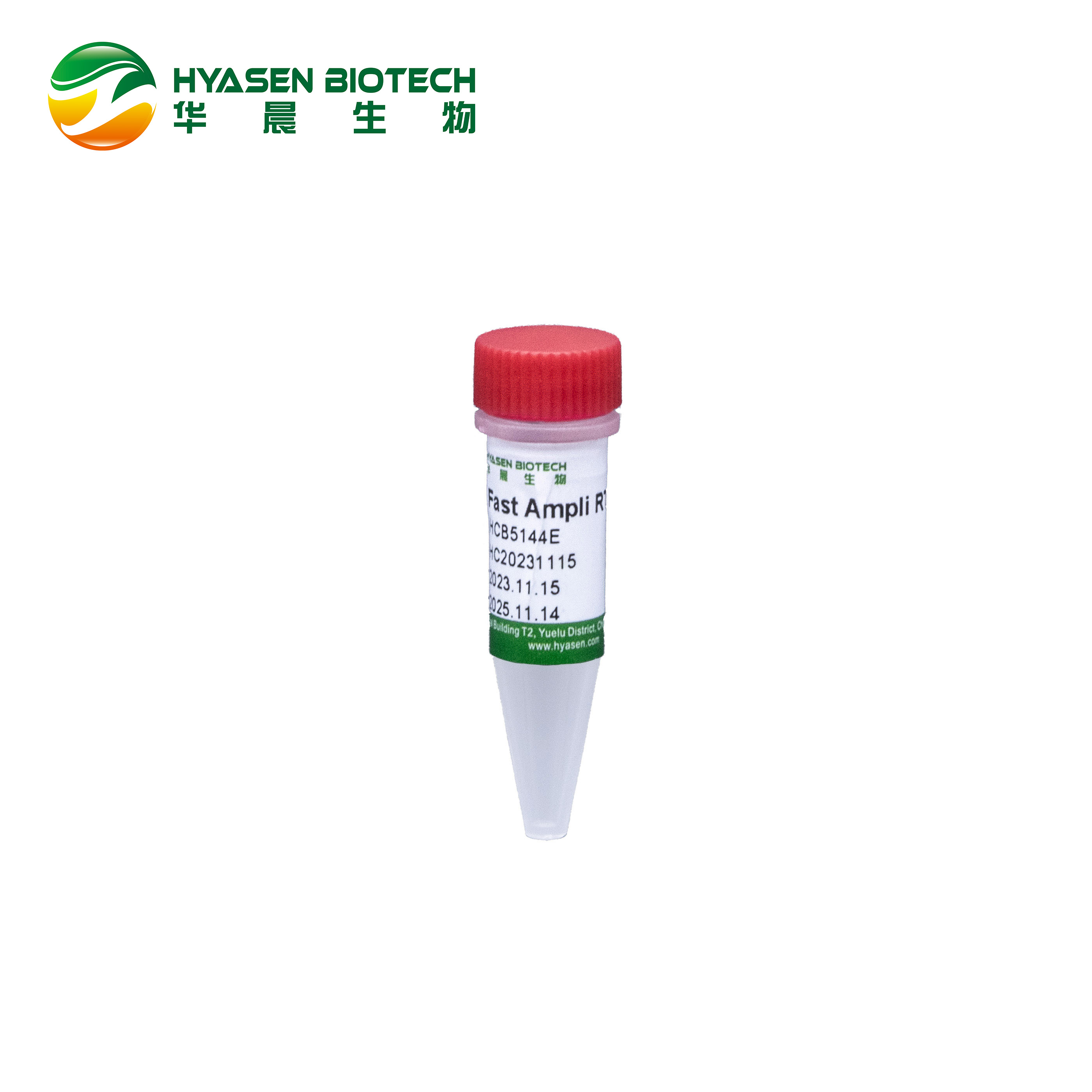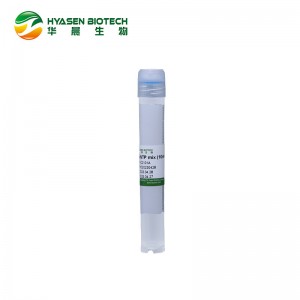
Fast Ampli RT-qPCR Premix plus-UNG
Cat No: HCB5144E
Fast Ampli RT-qPCR Premix plus-UNG is developed specifically for lyophilization processes, applied for fluorescence quantification (TaqMan probe) RNA amplification detection containing neocript reverse transcriptase and rapid amplification DNA Polymerase obtained by genetically modified and screening which can complete the PCR amplification within 20-40 minutes. This reagent preforms high inhibitor- tolerance, which has higher reverse transcription and PCR amplification efficiency, suitable for high-sensitivity amplification of low-concentration RNA samples. A good standard curve can be obtained within a wide quantitative range, and quantification can be carried out accurately. This reagent uses a mixed enzyme of anti-inhibition amplification enzyme and UNG enzyme, as well as an optimized buffer system containing dUTP. It can not only achieve good amplification of the target gene in samples containing inhibitors, but also effectively prevent false positive amplification caused by PCR residual and aerosol pollution. This reagent is compatible with most fluorescent quantitative PCR instruments, such as Applied Biosystems, Eppendorf, Bio-Rad, Roche and so on. This reagent can be used for lyophilization to obtain a good lyophilized form and product stability.
Reagent composition
1. 12.5×FastAmpli Part Taq/UNG Mix (with dNTPs) (DG)
2. 50× FastAmpli Part RTase (DG)
3. 5 ×FastAmpliRT Buffer (DG)
4. 4 ×lyoprotectant (optional) (DG)
Storage Conditions
Can be stored at -20℃ for Long-term, at 4℃ for up to 3 months. Mix well before use and Avoid frequent freeze-thaw.
Cycling Protocol
|
Step |
Temperature |
Regular PCR Procedure |
Fast PCR Procedure |
Cycles |
|
Duration |
Duration |
|||
|
Reverse Transcription |
50℃ |
15 min |
5 min |
hold |
|
Polymerase Activation |
95℃ |
1-5 min |
1-2 min |
hold |
|
Denature |
95℃ |
10-20 s |
1-3 sec |
40-50 |
|
Annealing/Extension |
56-64℃ |
20-60 s |
3-20 sec |
RT-qPCR Liquid Reaction System
|
Composition |
25µL Volume |
50µL Volume |
Concentration |
|
5×FastAmpli RT Buffer |
5µL |
10µL |
1× |
|
12.5×FastAmpli Part Taq/ UNG Mix (with dNTPs) |
2µL |
4µL |
1× |
|
50× FastAmpli Part RTase |
0.5µL |
1µL |
1× |
|
4×lyoprotectant |
6.25µL |
12.5µL |
1× |
|
25×Primer-Probe Mix |
1µL |
2µL |
1× |
|
Template RNA |
— |
— |
— |
|
ddH2O |
To 25µL |
To 50µL |
1× |
1. This system is a lyophilization system; When customers use this system without lyophilization requirements, 4×lyoprotectant can be selectively added; If there are lyophilized products required, during liquid reagents stage product performance validation, it must add 4×lyoprotectant to ensure consistency with the lyophilized system components and effects.
2. When use regular PCR procedure, the final concentration of primer is usually 0.2μM. For better results, the primer concentration can be optimized within the range of 0.2- 1.0μM. The probe concentration can be optimized within the range of 0.1-0.3μM. Concentration gradient experiments can be performed to find the best combination of primers and probes.
3. When using fast PCR amplification method, a better result can be achieved by increasing primer/probe concentration, as well as adjusting the percentage of primer and probe.
4. Different types of templates contain different copy number of target gene. A gradient dilution can be done to select appropriate optimal template addition amount, if necessary.
Lyophilization system preparation
|
Composition |
25µL Reaction System |
|
5×FastAmpli RT Buffer |
5µL |
|
12.5×FastAmpli Part Taq/UNG Mix (with dNTPs) (DG) |
2µL |
|
50×FastAmpli Part RTase (DG) |
0.5µL |
|
4×Lyoprotectant |
6.25µL |
|
25×Primer-Probe Mix |
1µL |
|
ddH2O |
To 18~20µL |
* If other systems for lyophilization is needed, please consult separately.
Lyophilization Process
|
Procedure |
Temp. |
Time |
Condition |
Pressure |
|
Freezing |
4℃ |
30 min |
Hold |
1 atm |
|
-50℃ |
60 min |
Cooling |
||
|
-50℃ |
180 min |
Hold |
||
|
Primary Drying |
-30℃ |
60 min |
Heating |
Ultimate Vacuum |
|
-30℃ |
720 min |
Hold |
||
|
Secondary Drying |
25℃ |
60 min |
Heating |
Ultimate Vacuum |
|
25℃ |
300 min |
Hold |
1. This lyophilization process is an in-situ freeze-drying process for a 25µL reaction system; if freeze-drying beads or other in-situ freeze-drying processes are required, please inquire separately.
2. The above lyophilization process is for reference only. Different product types and different freeze-dryers have different parameters, so adjustments can be made according to actual conditions during use.
3. Different lyophilization processes may be suitable for different batch sizes lyophilized products, so sufficient testing validation must be performed when used for large-scale production.
Instruction for using lyophilized powder
1. Briefly centrifuge the lyophilized powder;
2. Add nucleic acid template to the lyophilized powder and add water up to 25µL;
3. Mix well by centrifugation and run on machine.
Quality Control
1. Functional testing: sensitivity, specificity, reproducibility of RT-qPCR.
2. No exogenous nuclease activity, no exogenous endo/exonuclease contamination.
Technical Information:
1. The amplification rate of rapid DNA polymerase is no less than 1kb/10s. Different PCR instruments have different heating and cooling speeds, temperature control modes and thermal conductivity, thus optimization of your primer/probe concentration and running method in combination with your specific fast PCR instrument is essential.
2. The reverse transcription time is optimized according to the length of the fragment to be amplified. For longer fragments, the reverse transcription time can be appropriately extended.
3. The annealing extension temperature should be optimized based on the Tm value of the primer probe and the actual conditions of the reaction.
4. For primers with lower annealing temperature or longer than 200 bp fragments,3-step method is recommended.
5. Please use dedicated areas and pipettes before and after amplification, wear gloves and change them frequently; do not open the reaction tube after the PCR reaction is completed to minimize contamination of samples by PCR products.
6. The utilization efficiency of dUTP and sensitivity to UNG enzyme differ for different target genes, thus if using UNG system leads to a decrease in detection sensitivity, the reaction system should be adjusted and optimized. If technical support is required please contact us.


.jpg)












